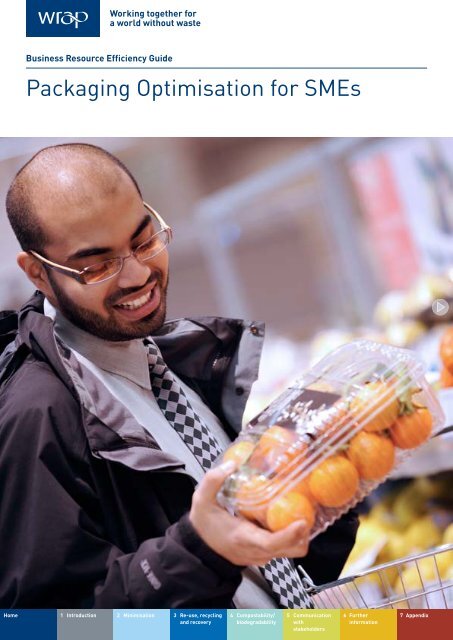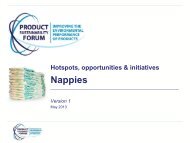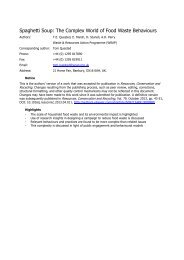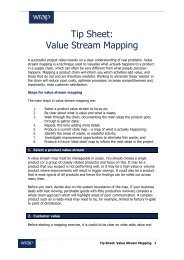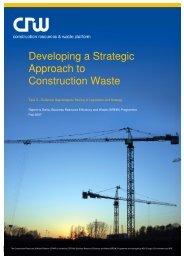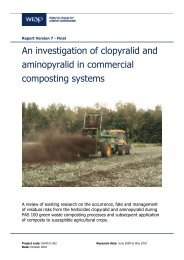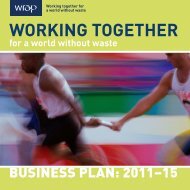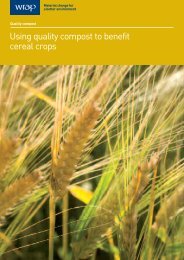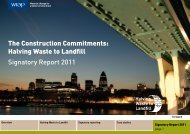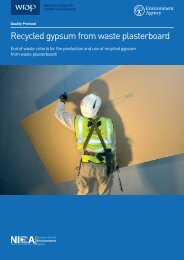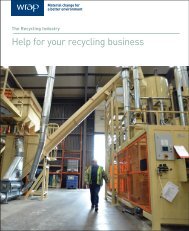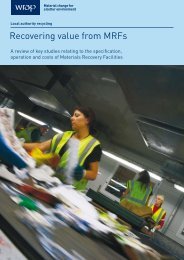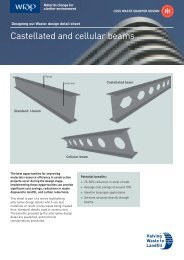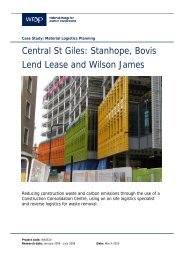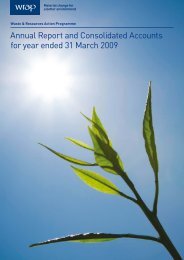Packaging Optimisation for SMEs - Wrap
Packaging Optimisation for SMEs - Wrap
Packaging Optimisation for SMEs - Wrap
- No tags were found...
Create successful ePaper yourself
Turn your PDF publications into a flip-book with our unique Google optimized e-Paper software.
Business Resource Efficiency Guide<strong>Packaging</strong> <strong>Optimisation</strong> <strong>for</strong> <strong>SMEs</strong>Home 1 Introduction 2 Minimisation 3 Re-use, recyclingand recovery4 Compostability/biodegradability5 Communicationwithstakeholders6 Furtherin<strong>for</strong>mation7 Appendix
WRAP<strong>Packaging</strong> <strong>Optimisation</strong> <strong>for</strong> <strong>SMEs</strong>IIOur vision is a world withoutwaste, where resources areused sustainably.We work with businesses andindividuals to help them reap thebenefits of reducing waste, developsustainable products and useresources in an efficient way.Find out more from the WRAPResource Efficiency Helpline on0808 100 2040 or at www.wrap.org.ukContents1 Introduction 21.1 The business opportunity 31.2 What is your company’s main objective? 31.3 Fitness <strong>for</strong> purpose 41.4 Under-packaging and over-packaging 41.5 Resource efficiency 42 <strong>Packaging</strong> optimisation by minimisation 62.1 Primary, secondary and tertiary 6packaging – the trade-offs2.2 Storage and handling 62.3 Luxury products and pre-packed fruit and 7vegetables2.4 <strong>Packaging</strong> considerations <strong>for</strong> other reasons 72.5 Benchmarking against ‘best in class’ 72.6 <strong>Packaging</strong> optimisation by transport efficiency 82.7 Other minimisation possibilities 92.8 Complying with the Essential Requirements 9Regulations3 <strong>Packaging</strong> optimisation by re-use, recycling and 11recovery3.1 <strong>Packaging</strong> optimisation by preparing <strong>for</strong> re-use 113.2 <strong>Packaging</strong> optimisation by recycling 123.3 <strong>Packaging</strong> optimisation by material or energy 15recovery4 <strong>Packaging</strong> optimisation by compostability/ 16biodegradability4.1 Biopolymers, biodegradability and 16compostability4.2 Trade-offs between biodregradability/ 16compostability and other environmental goals4.3 Classifications <strong>for</strong> materials to be classed 17as compostable/biodegradable4.4 Considerations to decide whether 17compostable packaging is appropriate4.5 Other points of consideration with 18compostable/biodegradable packaging5 Communication with stakeholders 195.1 Staff 195.2 Your business partners 195.3 Consumers 195.4 Local government 206 Further in<strong>for</strong>mation 217 Appendix 23Home1 Introduction 2 Minimisation 3 Re-use, recyclingand recovery4 Compostability/biodegradability5 Communicationwithstakeholders6 Furtherin<strong>for</strong>mation7 Appendix
WRAP <strong>Packaging</strong> <strong>Optimisation</strong> <strong>for</strong> <strong>SMEs</strong> 1SummaryThis guide explains the basics of packaging optimisation and willhelp you develop an action plan to save money and the environment’scritical resources.There are numerous terms used regarding packaging optimisation– recyclability, recycled content, re-usability, returnable packagingsystems, biodegradability, compostability, etc. This guide will help youto understand what all of these mean so you can choose the optionthat is right <strong>for</strong> your business. It has been specifically designed to bea packaging optimisation quick reference document that you can referto and gain an understanding of:•¡what the issues are in each of the different approaches;•¡how to incorporate the ideas into your process; and•¡what effect these changes will have on your costs andenvironmental impact.Today’s consumers expect products and services to fulfil their needs,while having the lowest possible environmental and social impacts.Society in general wants to be confident that companies are actingresponsibly.This guide will help you do that and will also help to:•¡support applications <strong>for</strong> ISO 14001 or other environmentalmanagement systems;•¡save money by making your operations more resource efficient;•¡demonstrate your commitment to sustainability and therebyimprove your reputation; and•¡increase your company’s competitiveness in the marketplace.It applies to complete systems, incorporating sales (primary),grouping (secondary) and transport (tertiary) packaging. It alsoincludes advice on how to communicate with a wide range ofstakeholders.It refers specifically to UK legislation, but will help companiesanywhere to optimise their use of packaging, thus reducingenvironmental impact, saving money and reducing resource use.The ultimate aim in optimising packaging and product systemsis to minimise the use of resources and the overall burden onthe environment throughout the product life-cycle. Taking theenvironment into account should not add to cost, provided it isconsidered throughout the initial design process. If environmentalconsiderations are only factored in at a late stage, then any changesnecessary are likely to be costly in terms of money and project delays.Home1 Introduction 2 Minimisation 3 Re-use, recyclingand recovery4 Compostability/biodegradability5 Communicationwithstakeholders6 Furtherin<strong>for</strong>mation7 Appendix
WRAP <strong>Packaging</strong> <strong>Optimisation</strong> <strong>for</strong> <strong>SMEs</strong> 21 IntroductionThe main purposeof packaging is tocontain and protectfood and other goodsfrom their point ofproduction throughto the point ofconsumption.Have you ever looked at your packagingand wished you knew how to reduce itsenvironmental impact or just thought thatoptimising its use could save you money?If so, this guide will explain the basics ofpackaging optimisation and help you developan action plan to save money and theenvironment’s critical resources.There are numerous terms you willhear when people talk about packagingoptimisation – recyclability, recycled content,re-usability, returnable packaging systems,biodegradability, compostability, etc. Thisguide will help you to understand what allof these mean so you can choose the optionthat is right <strong>for</strong> your business. It has beenspecifically designed to be a packagingoptimisation quick reference document thatyou can refer to and gain an understanding of:•¡what the issues are in each of the differentapproaches;•¡how to incorporate the ideas into yourprocess; and•¡what effect these changes will have on yourcosts and environmental impact.The guide explains how producers anddistributors of packaging and packaged goodscan optimise packaging and product systemsso that, as well as protecting the product andper<strong>for</strong>ming all the other functional roles, theymake a positive contribution to sustainableproduction, distribution, consumption and endof life.This means obtaining materials and energyfrom known, responsible sources andoptimising the packaging and product systemso that the materials and inherent energy canbe recovered after use.The main purpose of packaging is to containand protect food and other goods from theirpoint of production through to the point ofconsumption. The challenge is to do this byoptimising the use of materials, water andenergy; minimising waste (of product andused packaging); and maximising the recoveryof used packaging.Figure 1: Different packaging protection typesFigure 2: The concept of sustainability <strong>for</strong> packaging and product systemsRaw materials,energy sourcingManufacture,distributionUseEnd of lifeOptimising• Raw materials,energy, water• HazardouscomponentsMaximising• <strong>Packaging</strong>per<strong>for</strong>mance• Systemefficiency• LogisticsMinimising• Waste andreleases toair, waterHelpingconsumerslive moresustainablyMaximising• Recovery ofraw materialsand energyfrom usedpackagingHome1 Introduction2 Minimisation 3 Re-use, recyclingand recovery4 Compostability/biodegradability5 Communicationwithstakeholders6 Furtherin<strong>for</strong>mationProduction Distribution Consumption7 Appendix
WRAP <strong>Packaging</strong> <strong>Optimisation</strong> <strong>for</strong> <strong>SMEs</strong> 31.1 The business opportunityToday’s consumers expect products andservices to fulfil their needs, while havingthe lowest possible environmental andsocial impacts. Society in general wantsto be confident that companies are actingresponsibly.This guide will help you do that and will alsohelp to:•¡support applications <strong>for</strong> ISO 14001 or otherenvironmental management systems;•¡save money by making your operationsmore resource efficient;•¡demonstrate your commitment tosustainability and thereby improve yourreputation; and•¡increase your company’s competitivenessin the marketplace.up to it. This guide aims to help you on yourroad to achieving these targets and intentions.If you are looking at ways to improve yourpackaging, you must be clear about theenvironmental objectives you are aiming <strong>for</strong>:•¡reducing product wastage;•¡reducing your carbon footprint;•¡increasing the proportion of renewablematerials that you use;•¡reducing the amount of packaging you use;and•¡reducing the amount of packaging thatgoes to landfill.Figure 3: Cardboard collected <strong>for</strong> recyclinginstead of being sent to landfillIt applies to complete systems, incorporatingsales (primary), grouping (secondary) andtransport (tertiary) packaging. It also includesadvice on how to communicate with a widerange of stakeholders.It refers specifically to UK legislation, butwill help companies anywhere to optimisetheir use of packaging, thus reducingenvironmental impact, saving money andreducing resource use.1.2 What is your company’s main objective?There are many ways to optimise yourpackaging and this guide splits each strategyinto individual sections <strong>for</strong> easy reference.Your company needs to take into account allthe packaging design strategies covered inthis guide or it may run the risk of causingunintended consequences in other areas ofthe product life-cycle. However, it is likely thatone design strategy will be favoured abovethe others. This may be due to your companyhaving specific targets to meet as part of avoluntary agreement or perhaps it has madepublic statements about how it intends to usepackaging in the future and now needs to liveThese objectives can then be split intofocused optimisation strategies (ideally, tomaximise the reduction in environmentalimpact, all of these need to be consideredtogether):•¡packaging optimisation by minimisation;•¡packaging optimisation by re-use, recyclingand recovery; and•¡packaging optimisation by compostability/biodegradability.And, don’t overlook the main purpose ofpackaging (i.e. getting the product to its pointof use in good condition). Typically, 10 timesmore resources are used in products than intheir packaging.Home1 Introduction2 Minimisation 3 Re-use, recyclingand recovery4 Compostability/biodegradability5 Communicationwithstakeholders6 Furtherin<strong>for</strong>mation7 Appendix
WRAP <strong>Packaging</strong> <strong>Optimisation</strong> <strong>for</strong> <strong>SMEs</strong> 41.3. Fitness <strong>for</strong> purpose<strong>Packaging</strong> has to fulfil a number of corefunctions:•¡ensure that the contents are delivered tothe consumer or business end-user in goodcondition, whatever stresses and strains itundergoes during distribution and storage;•¡protect the contents from hazards suchas vibration, moisture, heat, odours, lightpenetration, micro-organisms or pestinfestation, and it must not leak;•¡be easy to open (but difficult to openaccidentally) and pilfer-resistant;•¡allow liquids to pour without spillage;•¡be as easy as possible to carry; and•¡<strong>for</strong> consumer goods, it must be attractiveenough to encourage people to buy them.There is nothing more wasteful than a productthat is never sold or used. <strong>Packaging</strong> <strong>for</strong>luxury or gift items may be more elaboratethan necessary to contain and protect theitem, but this does not mean it should beexcessive.<strong>Packaging</strong> usually carries in<strong>for</strong>mation aboutthe product, the company taking responsibility<strong>for</strong> it and instructions <strong>for</strong> handling or use. Itmay bear a logo indicating what material itis made from, a symbol or statement aboutrecycling and the anti-littering ‘tidyman’symbol. If the packaging doesn’t havesufficient surface area <strong>for</strong> all the necessaryin<strong>for</strong>mation to be displayed, consider usingan outer box so that a leaflet can be inserted.Another option is a fold-out label.It may also have to be re-sealable, tamperevidentand/or child-resistant.You need to balance reducing theenvironmental impact of packaging againstthe need to ensure that it meets all relevantper<strong>for</strong>mance criteria during production,distribution, storage and use.1.4. Under-packaging and over-packagingUnder-packaging is usually far worse <strong>for</strong> theenvironment than over-packaging.•¡Over-packaging by 10% means that 10%of the resources needed to produce thepackaging are wasted and extra fuel will beneeded to distribute it.•¡Under-packaging that results in theproduct being spoilt or damaged wastes100% of the resources used to produce thecontents of the pack and its packaging, andall the fuel used to distribute it.Ten times more energy and materials arelocked up in household goods and food thanin the packaging around them (Source:Dr J M Kooijman).Figure 4: A product damaged throughunder-packaging is far worse environmentallythan if it was over-packaged1.5. Resource efficiencyThe ultimate aim in optimising packagingand product systems is to minimise theuse of resources and the overall burden onthe environment throughout the productlife-cycle. Taking the environment intoaccount should not add to cost, provided itis considered throughout the initial designprocess. If environmental considerationsare only factored in at a late stage, then anychanges necessary are likely to be costly interms of money and project delays.It does not make sense to base your choiceof packaging on just one environmentalparameter because this will often lead tounintended consequences in other parts ofthe supply system.Home1 Introduction2 Minimisation 3 Re-use, recyclingand recovery4 Compostability/biodegradability5 Communicationwithstakeholders6 Furtherin<strong>for</strong>mation7 Appendix
WRAP <strong>Packaging</strong> <strong>Optimisation</strong> <strong>for</strong> <strong>SMEs</strong> 5A single focus on reducing the weight ofprimary packaging can have unintendedeffects, such as:•¡an increase in product wastage or anoverall increase in packaging weight ifsecondary or tertiary packaging has tobe increased to provide the same level ofproduct protection;•¡a disincentive to use recycled paper andsome plastics (because they may need tobe thicker, and there<strong>for</strong>e heavier, to provideequal functionality); and•¡similarly, <strong>for</strong> comparison, the unintendedconsequences of focusing on easilyrecyclable materials can be:--more waste <strong>for</strong> final disposal, even if avery high recycling rate is achieved –see Raw example materials, from Germany Manufacture, below; andenergy sourcingdistribution--more vehicle movements to deliverthe Optimising same quantity of product Maximising if thepackaging • Raw materials, is bulkier. • <strong>Packaging</strong>energy, waterper<strong>for</strong>manceIn the • 1990s, Hazardous packaged goods producers • Systemin Germany components were under pressure efficiency from theEnvironment Ministry to move away • Logistics frommulti-layer, composite materials Minimising and towardsmore recyclable packaging. The • Waste laminated andpouches then being used <strong>for</strong> instant releases coffee toair, waterweighed 11g, a metal can <strong>for</strong> the sameamount of product weighed 120g and a glassjar weighed 470g. Even with a high recyclingrate of 80%, the can would still generate 24gof waste (20% of 120g) and the jar 94g (20%of 470g). Only 11g becomes waste if pouchesare used, though they are not currentlyrecyclable. There<strong>for</strong>e, roughly three timesmore lorries would be needed to deliver thesame amount of product in jars or cans thanin pouches.This does not mean that the multi-layerpackaging is necessarily environmentallybetter than the other packaging options. Manyother factors have to be taken into account,such as product shelf-life, the amount andtype of grouping and transport packaging, andthe stresses and strains of the distributionsystem.UseEnd of lifeIt is seldom possible to optimise everyenvironmental requirement when selectinga material Helping or designing Maximising packaging <strong>for</strong>a particular consumers purpose. It will • Recovery rarely of bepracticable live more to prioritise these raw materials parameters in aparticular sustainably order and apply and the energy same prioritiesacross an entire product range. from usedpackagingYou should aim <strong>for</strong> overall optimisation ratherthan pursuing one environmental objective atthe expense of all the others.Figure 5: Steps <strong>for</strong> packaging optimisationProduction Distribution Consumption• Design• Raw material sourcing• Manufacturing• Supply chainmanagement• <strong>Packaging</strong> systems• Logistics• Responsible use• End-of-lifemanagement1L1L1 IntroductionHome Introduction 2 Minimisation 3 1L Re-use, 1L recyclingand recovery1L1L4 Compostability/biodegradability5 Communicationwithstakeholders6 Furtherin<strong>for</strong>mation7 Appendix
WRAP <strong>Packaging</strong> <strong>Optimisation</strong> <strong>for</strong> <strong>SMEs</strong> 62 <strong>Packaging</strong> optimisationby minimisationPolitical and pressattention focuses onprimary packaging,but if you reduce yourprimary packagingbe<strong>for</strong>e thinkingabout the additionalprotection that youmay need fromsecondary packaging,you could find thatyou have actuallyincreased your totalpackaging use.2.1 Primary, secondary and tertiarypackaging – the trade-offsConsider the total packaging system whendesigning packaging:•¡primary packaging – the pack that theconsumer takes home;•¡secondary packaging – inner cartons, trays,boxes (including retail-ready and displaypackaging);•¡tertiary packaging – the outer transportpackaging, such as pallets and stretchwrap, which is used in transportingproducts to the depot or distribution centre.the pallet, perhaps it could take the <strong>for</strong>m ofa frame. Material would be saved and theweight of the consignment reduced.The retail trade is increasingly demandingretail-ready packaging that reduces a store’slabour and handling costs. This can be atsignificant extra cost to the supplier and,unless you make changes in other areas, itinvolves a significant increase in packagingmaterial use. However, since retail-readypackaging also protects the product intransit, it may present opportunities <strong>for</strong>counterbalancing savings in the transportpackaging used.Figure 6: Primary packaging minimisationFigure 7: Retail-ready packaging allowingminimisation of primary packagingPolitical and press attention focuses onprimary packaging, but if you reduce yourprimary packaging be<strong>for</strong>e thinking about theadditional protection that you may need fromsecondary packaging, you could find that youhave actually increased your total packaginguse.Several items may be packed in a singlebox, which is the traded unit delivered to theretailer. A number of these boxes will oftenbe placed in a pallet shipper <strong>for</strong> delivery fromthe manufacturer to the distribution centreand then point of use. If the pallet shipper’sonly function is to hold the boxes in place on2.2 Storage and handlingReview your packaging in conjunction withyour own and your customers’ storage andhandling systems. For example:•¡If you add to the strength of your packagingsystem so that it can withstand morepressure, you may be able to stack moreproducts on top of one another, whichreduces your storage space requirement.•¡Slip-sheets are strong enough to supportthe weight of the product load without theneed <strong>for</strong> the rigid base that a pallet wouldprovide. Plastic slip-sheets can sometimesHome 1 Introduction2 Minimisation3 Re-use, recyclingand recovery4 Compostability/biodegradability5 Communicationwithstakeholders6 Furtherin<strong>for</strong>mation7 Appendix
WRAP <strong>Packaging</strong> <strong>Optimisation</strong> <strong>for</strong> <strong>SMEs</strong> 7be used to avoid the need <strong>for</strong> pallets,particularly <strong>for</strong> overseas shipments andinter-company deliveries. This saves spaceand materials.•¡If you are transporting high-value, fragileproducts, you may want to considerthe mode of transport used and thealternatives if product damage is occurring.•¡WRAP research 1 shows that manualhandling can be a major cause of productdamage. This can happen during orderpicking at regional distribution centres, inroll-cage use and during manual shelffilling.Check whether this applies toyou and your customers. If it does, thenperhaps better staff training can help.2.3 Luxury products, and loose/pre-packedfruit and vegetablesDepending on the nature of the product andits supply chain, there may well be greaterpotential <strong>for</strong> savings in transport packagingthan in primary packaging, but the issue ofconsumer perception must not be overlooked.•¡A luxury product may need packagingthat looks opulent, but can that effect beachieved with clever graphics, and higherqualityprint and packaging materialsrather than by protecting your primarypacking with a box and protecting the printon the box with a layer of film? Could youuse point-of-sale displays rather thanincreasing the packaging on every item?•¡It is best to give people a choice betweenpre-packed and unpackaged fruit andvegetables. Where shops don’t have space<strong>for</strong> both, look up the research on spoilagerates <strong>for</strong> each type of produce and make adecision which will balance real packaginguse (which includes the bags the retailerprovides), perceived packaging use (whatis on display) and food wastage rates – anissue which is rightly getting more andmore attention.Some people want to buy their fruit andvegetables pre-packed rather than take thetime to pack them in the store’s producebags themselves, whereas others want to buyunpackaged produce.Goods that are not pre-packed are morelikely to be damaged or bruised, but carefulshoppers will select items in good condition.An unpackaged cucumber is fine if theconsumer is going to use it within a coupleof days, but a cucumber wrapped in film willkeep until the next weekly shop.Remember that all products needcontainment to get them to the point ofsale. Crates and trays are always neededto transport the product from grower to theretail outlet, whether the produce has comefrom abroad or from local growers.2.4 <strong>Packaging</strong> considerations <strong>for</strong> otherreasonsThe conventional way to discourageshoplifting of small, valuable, retail itemsis by packing them in a blisterpack with abacking card, but is the conventional way stillthe best way <strong>for</strong> you?•¡Could you replace the blisterpack with asimpler option, such as a single material?•¡Do you need the backing card to provide allthe in<strong>for</strong>mation that the consumer needs?If not, there may be a case <strong>for</strong> a rethink. Ifthe product is relatively valuable and largeenough, a security tag could be a viablealternative.•¡Could the product be stored behind thecounter or in a locked display cabinet? Thiswon’t always be feasible, but it works <strong>for</strong>cigarettes, over-the-counter medicines andperfumes.2.5 Benchmarking against ‘best in class’It can be useful to benchmark your productsagainst those of your competitors. If theyhave come up with a packaging design thatyou have not considered or have minimised/optimised an existing design, find out:•¡How successful has the innovation beencommercially?•¡Has there been any effect on market share?•¡Given your filling and handling equipment,and distribution chain, would it be feasible<strong>for</strong> you to develop something similar?•¡If the new design involves less primarypackaging, what changes have been madeto the secondary or transport packaging?1 www.wrap.org.uk/content/resource-efficient-distributionHome 1 Introduction2 Minimisation3 Re-use, recyclingand recovery4 Compostability/biodegradability5 Communicationwithstakeholders6 Furtherin<strong>for</strong>mation7 Appendix
WRAP <strong>Packaging</strong> <strong>Optimisation</strong> <strong>for</strong> <strong>SMEs</strong> 8•¡Is there an overall packaging reduction oronly a perceived reduction?•¡What effect has the new packaging designhad on product loss rates or customersatisfaction/complaints?If the in<strong>for</strong>mation to answer these questionsisn’t publicly available, you can always getcompetitors’ packaging tested to ascertain thematerials used, its weight and the protectionit provides, and compare this with what youhave in place.WRAP publishes ‘best-in-class’ packagingweight data 2 on its website. This may help youidentify where you seem to be falling short ofbest practice. Remember that:•¡your packaging may not necessarily be inthe same ‘class’ as the best that WRAPhas found (different distribution channels,different markets, ageing equipment thatyou cannot af<strong>for</strong>d to replace); and•¡minimum weight does not necessarilymean minimum environmental impact.If you are using more packaging than youneed just so that your product occupiesthe same amount of shelf space as yourcompetitors, talk to your trade associationand see if the whole sector could agree toreduce its packaging – and costs.See the checklist ‘<strong>Packaging</strong> optimisation byminimisation’in the Appendix.2.6 <strong>Packaging</strong> optimisation by transportefficiencySometimes, one of the largest environmentalimpacts of a packaging system is the energy(fuel) used in the transportation of theproduct. There<strong>for</strong>e, to reduce this burden,packaging can be optimised with this in mind.For example, if your main transportationmode is air freight (due to short lifespans ofproducts coming from far away), it would besensible to minimise your packaging weight(e.g. a lightweight, recyclable plastic in acartonboard box instead of glass containerstransported in heavier wooden crates).If your main transportation method is bytruck, consider designing your packaging sothere is minimal space between packs. Alsothink about designing primary packagingso it can stack easier into each other. Thisincreases the number of packs that can becontained in each box, the number of boxesstacked on each pallet and the number ofpallets that can fit into each truck.Alternatively, if your product includes ahigh concentration of water, <strong>for</strong> examplelaundry detergents, can you create a moreconcentrated pack where the consumerdilutes the product at home? This coulddramatically reduce the packaging materialneeded to contain the product (and,there<strong>for</strong>e, disposed of at end of life), andthe transportation ef<strong>for</strong>t needed to get yourproduct to your consumer and to the recyclingfacility once the product has been used.See the checklist ‘<strong>Packaging</strong> optimisation <strong>for</strong>transport efficiency’in the Appendix.2.7 Other minimisation possibilities•¡Could a change in product or packagingdesign allow a reduction in the size orweight of the packaging while maintainingits capacity?•¡Could less packaging material be used bymodifying the volume sold (e.g. more salesunits per box, larger portions, bulk or evenloose)?•¡Could you reduce packaging by changingthe physical nature of the contents or byusing an alternative material?•¡Are additional materials such asintermediate layers, shrink wrap, adhesivesand tapes all necessary? Could they bereplaced with waste material (shreddedpaper/board) that you would normallythrow away?•¡Could the distribution system be modifiedin a way that would reduce energyconsumption or the amount of packagingneeded?•¡Could certain components be strengthenedor weakened to reduce overall materialuse?2 www.wrap.org.uk/content/uk-packaging-benchmark-databaseHome 1 Introduction2 Minimisation3 Re-use, recyclingand recovery4 Compostability/biodegradability5 Communicationwithstakeholders6 Furtherin<strong>for</strong>mation7 Appendix
WRAP <strong>Packaging</strong> <strong>Optimisation</strong> <strong>for</strong> <strong>SMEs</strong> 92.8 Complying with the <strong>Packaging</strong> (EssentialRequirements) RegulationsThe <strong>Packaging</strong> (Essential Requirements)Regulations aim to minimise the amount ofwaste packaging that is generated at sourceand to ensure that packaging can be reused,recycled or recovered. There<strong>for</strong>e, if youare seen to be ‘over-packing’ your productunnecessarily, you may be reported to TradingStandards by your competitors or consumers.There<strong>for</strong>e, it is important <strong>for</strong> you to work withyour suppliers and customers to identify whatit is that prevents you from reducing yourpackaging further. When you have identifiedthis ‘critical area’, check if there are ways toremove the barriers and implement changes.An ‘unacceptable’ pack failure rate is a matterof commercial judgment – it will be different<strong>for</strong> a high-value product, such as a televisionset, than <strong>for</strong> a low-value product, such aswashing-up liquid, and <strong>for</strong> products whereleakage could endanger people or property.The packaging manufacturing or packing/filling process also has to be taken intoaccount. It may only be possible <strong>for</strong> you toreduce your packaging further if you buy newmachinery. This is not expected or demanded,as it may not be economically practicable orenvironmentally desirable to scrap equipmentbe<strong>for</strong>e it reaches the end of its life.2.8.1 Consumer acceptanceIf you reduce your packaging to the pointwhere the product is unacceptable to theconsumer, it won’t sell and there is no point inproducing it.Consumers have expectations regarding theappearance and functionality of the packagingaround the products they buy, but if you areusing more packaging than is needed <strong>for</strong>functional purposes, you must be able tojustify this.If you have identified consumer acceptabilityas the critical area that prevents furtherminimisation, the en<strong>for</strong>cement authoritiescan always ask you to show the evidencethat proves this. Your evidence could bemarket research results or the findings frombenchmarking exercises – if a competitorchanged packaging, what effect did that havein the marketplace?2.8.2 DocumentationTo show that you have complied withthe <strong>Packaging</strong> (Essential Requirements)Regulations, you need to document theresults of any assessments, preparea statement of con<strong>for</strong>mity and keepyour records <strong>for</strong> possible inspection.Documentation can be based on test results,studies or practical experience.It is also advisable to maintain a historicalrecord of packaging so you can demonstrateimprovement over time.The packer/filler puts together much of thisin<strong>for</strong>mation, with help from suppliers andcustomers. If you supply empty packaging toa packer/filler, remember that you are thepacker/filler of the outer packaging you use toship the goods.2.8.3 Minimising heavy metals and otherdangerous substancesThe components that make up your packagingmust contain less than 100 parts per million(ppm) of the combined concentrations of lead,cadmium, mercury and hexavalent chromium,and only the minimum necessary quantitiesof substances identified as noxious orhazardous. As a packer/filler, you need to relymainly on packaging suppliers and suppliersof components, such as closures and labels,to find out this in<strong>for</strong>mation.It is very rare that the heavy metal limits areexceeded or that substances classified asdangerous to the environment are presentin packaging manufactured in Europe or theUSA.However, companies must exercise ‘duediligence’ when relying on a packagingsupplier’s input. This is particularly important<strong>for</strong> imported goods.You will normally be able to fulfil your legalobligations by asking your suppliers toprovide in<strong>for</strong>mation on the heavy metals andany dangerous substances in the packaging orpackaging components supplied to you.Home 1 Introduction2 Minimisation3 Re-use, recyclingand recovery4 Compostability/biodegradability5 Communicationwithstakeholders6 Furtherin<strong>for</strong>mation7 Appendix
WRAP <strong>Packaging</strong> <strong>Optimisation</strong> <strong>for</strong> <strong>SMEs</strong> 10The Industry Council <strong>for</strong> <strong>Packaging</strong> andthe Environment’s (INCPEN) Responsible<strong>Packaging</strong> Code of Practice has a standardletter requesting this in<strong>for</strong>mation.If the amount of heavy metals exceeds thelimits or if any substances dangerous to theenvironment have not been reduced to theabsolute minimum necessary, this must becorrected be<strong>for</strong>e a statement of con<strong>for</strong>mity isissued.2.8.4 Simplified compliance <strong>for</strong> glass, andpaper and boardIf you are using glass or paper and boardpackaging, Local Government Regulation(<strong>for</strong>merly the Local Authorities Coordinatorsof Regulatory Services (LACORS)) hasendorsed standard protocols and guidancedocuments, drawn up by British Glass andthe Confederation of Paper Industries (CPI),that you can use to show compliance withthe <strong>Packaging</strong> (Essential Requirements)Regulations.Home 1 Introduction2 Minimisation3 Re-use, recyclingand recovery4 Compostability/biodegradability5 Communicationwithstakeholders6 Furtherin<strong>for</strong>mation7 Appendix
WRAP <strong>Packaging</strong> <strong>Optimisation</strong> <strong>for</strong> <strong>SMEs</strong> 113 <strong>Packaging</strong> optimisation by re-use,recycling and recoveryThe most common<strong>for</strong>m of re-use <strong>for</strong>consumer productsis re-usable, strongpackaging whichstays with theend-user.It is important to note the differences betweenthe terms re-use, recycling and recovery asthey are commonly confused. In summary:•¡preparing <strong>for</strong> re-use is the use of a productor packaging <strong>for</strong> a second (or more) use,either <strong>for</strong> the same or different function,but without any processing of the productor packaging;•¡recycling is the re-processing of a productor its packaging into another product orpackaging (which could be of the same typeof product or packaging, or be somethingcompletely different made from therecycled material); and•¡recovery is the process of recoveringmaterial (or energy) from used productsor packaging, this can include composting(where material is recovered), but ifyou compost in compliance with qualityprotocols, then you can also define thisas recycling 3 . You can also recover energyfrom waste (where energy is gained fromwaste materials being incinerated).3.1 <strong>Packaging</strong> optimisation by preparing <strong>for</strong>re-useAlthough refillable beer and soft drinkbottles have more or less disappeared andthe doorstep delivery system <strong>for</strong> milk isin decline, re-usable packaging is on theincrease in the business-to-business sector– pallets; roll-cages; metal; plastic andfibreboard drums; beer kegs; crates; andtrays <strong>for</strong> bread and other products.When it is left to private consumers to returnthe used packaging, their willingness to do sodepends on how easily this fits into the waythey live. If you want to introduce re-usableconsumer packaging, you must make it asconvenient as possible <strong>for</strong> them to return theempties.The most common <strong>for</strong>m of re-use <strong>for</strong>consumer products is re-usable, strongpackaging that stays with the end-user(e.g. biscuit tin, spice jar, coffee jar, laundrydetergent bottle) and is refilled fromone-way, lighter-weight packaging that isused to take the product home (e.g. roll wrap<strong>for</strong> biscuits, plastic sachet in a box <strong>for</strong> spices,laminate coffee pack, flexible pouch <strong>for</strong>laundry detergent).Re-usable packaging may be part of a ‘closedloop’system in which it circulates within acompany or between two companies, and isoften referred to as returnable packaging ora returnable packaging system. Alternatively,re-usable packaging can stay within anorganised group of companies. This could bethe case <strong>for</strong> the supply of components to, say,a car manufacturer.Figure 8 Returnable plastic cratesIn ‘open-loop’ systems, re-usable packagingcirculates among unspecified companies(e.g. CHEP pallets) or can be provided toconsumers <strong>for</strong> re-use.3.1.1 Checklist <strong>for</strong> ‘Preparing <strong>for</strong> re-use’•¡Ensure that the packaging is designed <strong>for</strong>and is robust enough <strong>for</strong> re-use.•¡Check that your business partners will alsotreat the packaging as re-usable and willreturn it as appropriate or that collectionarrangements are in place to enableprivate end-users to return it.3 www.defra.gov.uk/publications/files/pb13530-waste-hierarchy-guidance.pdf3 Re-use, recyclingHome 1 Introduction 2 Minimisation 4 Compostability/and recoverybiodegradability5 Communicationwithstakeholders6 Furtherin<strong>for</strong>mation7 Appendix
WRAP <strong>Packaging</strong> <strong>Optimisation</strong> <strong>for</strong> <strong>SMEs</strong> 12•¡Ensure that facilities <strong>for</strong> cleaning, repairingor reconditioning are available if this isnecessary be<strong>for</strong>e the packaging can bere-used.•¡Obtain written confirmation from yoursupplier that the packaging is capableof re-use and confirmation from yourcustomers that they intend to place thepackaging into a re-use circuit.•¡If possible, work out the lifespan or numberof uses of the packaging be<strong>for</strong>e it needs tobe replaced. This in<strong>for</strong>mation can be usedto determine if re-usable packaging isactually the cheapest/most environmentallybeneficial option.Re-usable packaging benefits theenvironment only if it is actually returnedand used <strong>for</strong> re-use. Keep your system underreview and take corrective action if the returnrate falls to an unacceptable level.The European Committee <strong>for</strong> Standardization(CEN) has published a report setting outmethods <strong>for</strong> assessing the per<strong>for</strong>mance of are-use system by calculating the proportion ofre-used packaging in use.A standard is now available from theBritish Standards Institution atPD CEN/TR 14520:2007 4 .3.1.2 ‘In<strong>for</strong>mal’ re-useYou may also find an in<strong>for</strong>mal, secondary use<strong>for</strong> packaging that is not actually designed tobe re-usable, particularly if this use is not asdemanding as the principal function.•¡Could you re-use the transport packagingaround goods you have received <strong>for</strong> sendingout products to your customers?•¡Could you re-use transport packaging inhouse(e.g. as trays in which consumerscan take plants away from a gardencentre)?See the checklist ‘<strong>Packaging</strong> optimisation bypreparing <strong>for</strong> re-use’ in the Appendix.3.2 <strong>Packaging</strong> optimisation by recyclingOptimising packaging specifically <strong>for</strong> recyclingis often beneficial <strong>for</strong> packaging madepredominantly from glass, metals, board orrigid plastics. This is because the packagingtypically contains sufficient material to justifyspending additional resources to collect it<strong>for</strong> recycling after it has been used. However,<strong>for</strong> recyclability to be successful, a robustinfrastructure needs to be in place (or theability <strong>for</strong> one to be created) to collect,segregate and clean the packaging in a waythat will yield a net gain in resources.In these circumstances, recycling willmake a positive contribution to the overallresource efficiency of the complete life-cycle.There<strong>for</strong>e, it is important to avoid adding anycomponents that may become contaminantsin the recycling process.The packaging materials most widelycollected <strong>for</strong> recycling from householders,either directly from the kerbside or through‘bring’ banks, are aluminium cans, steelcans, glass bottles and jars, and plasticbottles. In some areas, folding cartons,milk and juice cartons, and plastic carrierbags are also collected. Note, aluminiumfoil can be recycled, but metallised plasticfilm (often called ‘foil’), which looks similar,usually cannot, but its energy content can berecovered. All kerbside schemes also collectnewspapers and magazines.Figure 9: Commonly recycled materialsDo not re-use packaging that is not designed<strong>for</strong> re-use if there is any question of a risk tosafety (e.g. if you are filling products, suchas carbonated soft drinks, which exert apressure greater than atmospheric pressure).4 http://shop.bsigroup.com/ProductDetail/?pid=0000000000301588403 Re-use, recyclingHome 1 Introduction 2 Minimisation 4 Compostability/and recoverybiodegradability5 Communicationwithstakeholders6 Furtherin<strong>for</strong>mation7 Appendix
WRAP <strong>Packaging</strong> <strong>Optimisation</strong> <strong>for</strong> <strong>SMEs</strong> 133.2.1 Options <strong>for</strong> making packagingcompatible with collection <strong>for</strong> recyclingsystems•¡Try to avoid types of materials,combinations of materials or designs ofpackaging that might create problems incollecting, sorting or recycling.•¡Minimise the use of substances ormaterials that might create technical,environmental or health problems in therecycling process or in the disposal ofrecycling residues.•¡Minimise the use of substances ormaterials that might have a negativeinfluence on the quality of the recycledmaterial. For example, do you need acolour tint on your plastic bottle or couldyou achieve the same effect with an eyecatchinglabel?•¡Ensure that you don’t make the packagingincompatible with the recycling process ifyou change your raw material sourcing oryour manufacturing, converting and fillingprocesses.•¡Ensure that you don’t create newcompatibility problems if you change thecoatings, adhesives, inks, labels, closuresand other sealing materials that wereselected at the design stage.•¡Try to design your packaging so thatminimum product residues remainwhen the used packaging is collected <strong>for</strong>recycling. For example, pump-action, liquidsoap with a suction tube that is too short toreach the bottom of the container and thefinal parts of the product.•¡Construct your packaging so that the endusercan easily separate any componentsthat should not go into the recyclingprocess (‘ease of disassembly’).If you are introducing an innovative packagingmaterial or system, there may be noestablished collection or recycling system<strong>for</strong> it. It takes time to develop and expandrecycling facilities <strong>for</strong> innovative packaging.The CEN recycling standard 5 advises thatnew types of packaging may be classified asrecyclable provided active steps are beingtaken to develop recycling <strong>for</strong> it.3.2.2 PlasticsOptimising plastic packaging <strong>for</strong> recyclinginvolves particular challenges. To provide justthe right technical properties <strong>for</strong> differentfunctions, different polymers are often usedin combination. When considering polymers,remember the following:•¡If combinations of material type areunavoidable, try to use materials ofdifferent densities so as to facilitateseparation.•¡Fillers that change the density of theplastic should be avoided or their useminimised as they lower the quality of therecycled material.•¡Match the polymer type used <strong>for</strong> the labelto that of the container. Paper labels don’tcreate recycling problems <strong>for</strong> plasticcontainers provided you use water-solubleadhesives and avoid labels coated in away that prevents separation and removalduring reprocessing.•¡Ensure that closures, liners and cap sealsdon’t interfere with the recyclability ofthe material to be recycled – they shouldideally be made from the same material.•¡Avoid using metal caps on plasticcontainers as they are difficult to removeand may cause contamination in recyclingstreams.•¡Tamper-evident sleeves and seals shouldbe designed to detach completely fromthe container or be easily removed inconventional separation systems.•¡The polymer identification symbol shouldbe shown clearly. Ideally, it should beembossed on the base of the container orat least close to the base.•¡Try to avoid printing the material identifieron the label, as it would not be clearwhether it refers to the label material, thecontainer plastic or the complete container,including the lid.Where coloured plastic is specified, be awareof the following:•¡Unpigmented polymers are more valuableas recyclate than pigmented polymers.So, if you are using a colourless plasticpackaging material, it is better to attach anadhesive label than print on the packagingitself.5 http://shop.bsigroup.com/ProductDetail/?pid=0000000000300975073 Re-use, recyclingHome 1 Introduction 2 Minimisation 4 Compostability/and recoverybiodegradability5 Communicationwithstakeholders6 Furtherin<strong>for</strong>mation7 Appendix
WRAP <strong>Packaging</strong> <strong>Optimisation</strong> <strong>for</strong> <strong>SMEs</strong> 14•¡Plastic tubs made from clear or colourlessmaterial and with the in<strong>for</strong>mation printedon the lid are more likely to be recycledthan those made from coloured plastics.•¡The reprocessor specification <strong>for</strong>pigmented plastics is less sensitive to lowlevels of ink contamination. So, wherecoloured plastics are used, there should beno problem printing on the container.•¡Where printing on coloured plastics isnecessary, use as little pigment as possiblein the ink because automated sortingequipment often can’t identify stronglylight-absorbing objects.3.2.3 Trade-offs between recyclability andother environmental goalsCurrently, optimising packaging <strong>for</strong> recyclingis not viable <strong>for</strong> packaging made from thinlayers of mixed materials or plastic films.This is because more resources are usuallyrequired to collect and clean it than can berecovered from the material. Much of thispackaging may also be contaminated byfood residues, which means that even if it iscollected <strong>for</strong> recycling, there may be a highrejection rate at the sorting plant.However, this type of packaging may haveenvironmental advantages further up thesupply chain by allowing more products tobe packaged onto one delivery vehicle, whichwould mean fewer vehicle movements,less traffic congestion and lower fuelconsumption. At the end of its life, energy canalso be recovered from this type of materialat the increasing number of areas in the UKwhere waste is being treated in energy-fromwasteplants.If you find that you have a choice betweenpackaging that will not get collected <strong>for</strong>recycling and packaging that will probably getcollected – assuming that both have the rightfunctional properties – you should comparethe resource requirements (and possibly thetransport efficiencies) of the two systemsbe<strong>for</strong>e making your decision.This is not to suggest that you should carryout a full life-cycle assessment every timeyou review your packaging. However, you canmake top-line calculations that may guideyour decisions by looking at:•¡what the effect would be on the weight andvolume of the pack;•¡if the fuel savings per distribution vehiclewould be significant; and•¡if the number of vehicle loads required toship a given quantity of product could bereduced.3.2.4 Trade-offs between recycled contentand other environmental goalsRecycled materials have been used in mosttypes of packaging <strong>for</strong> many years. For somematerials, there are trade-offs that need to beconsidered.Metal packaging (e.g. aluminium and steel)often has a high recycled content and this hasno effect on functional per<strong>for</strong>mance.Likewise, glass packaging often has a highrecycled content and this has no effect onfunctional per<strong>for</strong>mance. In recent years,there has been an issue about the colour ofglass to specify because, owing mainly to ourwine consumption, the UK imports a lot ofgreen glass, but we need relatively little <strong>for</strong>our own production. The surplus tends to berecycled into low-value applications, such asaggregate, that may not be as environmentallybeneficial as bottle-to-bottle recycling.There<strong>for</strong>e, it is worth considering:•¡If you are importing drinks or any otherproduct in green glass, would white flintglass do as well <strong>for</strong> product protection andmarketing purposes?•¡If you are filling glass containers in the UK<strong>for</strong> the export market, could you use greenglass?•¡If you use white flint glass, does it have tobe crystal clear or could you accept thecloudier appearance that would result fromcontamination with coloured glass?Often, paper and board packaging <strong>for</strong> nonfoodcontact use contains high levels ofrecycled content. However, paper packagingwith a high recycled content may have to beheavier than packaging made from virginfibres. This is because each time fibres arerecycled, they lose strength so more fibresare needed to achieve the same level ofprotection.3 Re-use, recyclingHome 1 Introduction 2 Minimisation 4 Compostability/and recoverybiodegradability5 Communicationwithstakeholders6 Furtherin<strong>for</strong>mation7 Appendix
WRAP <strong>Packaging</strong> <strong>Optimisation</strong> <strong>for</strong> <strong>SMEs</strong> 15•¡For weight (e.g. transport efficiency)reasons, do you need to specify virgin fibrerather than recycled fibre?•¡When virgin fibre is specified, can youensure that it is sourced from sustainablymanaged <strong>for</strong>ests, which comply withrecognised standards?Historically, plastics packaging, especiallythat used in food-contact applications, hasseldom contained high levels of recycledcontent – mainly <strong>for</strong> contamination reasons.However, technology is moving fast in thisarea and it is now possible to use recycledplastics <strong>for</strong> food packaging. Because of this,it is worth checking with reprocessors and theBritish Plastics Federation to find out whatis available. WRAP also publishes studies 6 inthis area, which might be worth investigating.See the checklist ‘<strong>Packaging</strong> optimisation byrecyclability’ in the Appendix.3.3 <strong>Packaging</strong> optimisation by material orenergy recoveryAlthough recycling is often an effective wayof recovering resources from packagingwaste, it is not the only way. The next sectioncovers optimising packaging with recoveryin mind through composting. Note thatstatistics about recycling rates usually referto the combined amount of material sent <strong>for</strong>recycling and composting.Figure 10: Energy from waste plantThe UK plans to recover the energy from25% of its municipal solid waste by 2020(twice the current rate). There<strong>for</strong>e, if yourpackaging is likely to be heavily contaminatedby the residual contents or if you decide thatlaminates are the most appropriate <strong>for</strong>mof packaging <strong>for</strong> you, then this may be anacceptable alternative to recycling.To be classed as energy recoverable,packaging must generate more energy thanis needed to drive the combustion process. Tobe sure of this ‘calorific gain’, the net calorificvalue must be at least 5MJ/kg.A CEN standard 7 includes a <strong>for</strong>mula <strong>for</strong>calculating the net calorific value of a packconsisting of various constituents. However,in most cases, it isn’t necessary to make anycalculations, since the standard providesthat the following types of packagingcan automatically be considered energyrecoverable:•¡packaging composed of over 50% by weightof organic materials (e.g. wood, cardboard,paper and other organic fibres, starch,plastics); and•¡thin-gauge aluminium foil (up to 50µmthick).<strong>Packaging</strong> consisting of more than 50% byweight of inorganic material (e.g. ceramic,glass, clay, metals) may be declared energyrecoverable if it can be shown that there iscalorific gain.The only specific consideration is to ensurethat any noxious or hazardous constituents ofpackaging should have minimum impact onthe environment when it is treated to recoverenergy, and that the combined concentrationsof lead, cadmium, mercury and hexavalentchromium do not exceed 100 ppm (except inplastic crates and pallets used in a closedloopsystem, which are exempted from thisrequirement).See the checklist ‘<strong>Packaging</strong> optimisation bymaterial or energy recovery’ in the Appendix.6 www.wrap.org.uk/content/food-grade-recycled-polypropylene-pp-packaging7 http://shop.bsigroup.com/ProductDetail/?pid=0000000000300948003 Re-use, recyclingHome 1 Introduction 2 Minimisation 4 Compostability/and recoverybiodegradability5 Communicationwithstakeholders6 Furtherin<strong>for</strong>mation7 Appendix
WRAP <strong>Packaging</strong> <strong>Optimisation</strong> <strong>for</strong> <strong>SMEs</strong> 164 <strong>Packaging</strong> optimisation bycompostability/biodegradabilityCompostablepackaging materialsare attractiveto caterers andretailers becausemany unsold, outof-datepackagedfoodstuffs can besent <strong>for</strong> compostingwithout the need tounpack it.4.1 Biopolymers, biodegradability andcompostabilityThere are three main types of biodegradablepackaging and are described below.4.1.1 DegradableWhen considering plastics, degradablepackaging often contains additives to breakdown the traditional plastic over a period oftime. This packaging is sometimes knownas ‘oxo-degradable’. The main considerationwith this type of packaging is that it can oftenget mistaken <strong>for</strong> the traditional plastic andmay then contaminate the recycling stream.Care must be taken when considering thistype of plastic so that it ends up where it issupposed to. Any <strong>for</strong>m of degradable plasticis much worse in landfill as it emits methane,a greenhouse gas that has a global warmingpotential of over 20 times that of carbondioxide (CO 2).4.1.2 BiodegradableBiodegradable packaging usually consistsof a biological component such as starch,cellulose or other plant fibres. This means itcan be broken down biologically by microbes.As with degradable packaging, there isconcern if biodegradable material is mistaken<strong>for</strong> traditional types of packaging material andends up in the recycling stream or in landfill.However, this is less likely as it often looksquite different.4.1.3 CompostableComposting is a managed process wherebiodegradable material is broken down bymicroorganisms in the presence of oxygento produce CO 2, water, minerals and organicmatter (compost or humus). Compostablediffers from biodegradable as the endproduct is usable compost. Products madefrom compostable plastic are tested andwill biodegrade/disintegrate under standardtest conditions set out in the relevant CENstandard 8 .It is also important to note than not allmaterials can be composted at home becausesome require high temperatures to breakdown and these are only possible to achieve incommercial composting systems. There<strong>for</strong>e,care must also be taken that this does not endup in recycling streams or landfill.Figure 11: Compostable packagingCompostability isn’t an inherent property of amaterial. It depends on the particular <strong>for</strong>m itis in – a thin film might be compostable, butthe same material in a thicker <strong>for</strong>m may notbe.Compostable packaging materials areattractive to caterers and retailers becausemany unsold, out-of-date packaged foodstuffscan be sent <strong>for</strong> composting without the needto unpack it.WRAP has also developed some biopolymerguidance 9 which can help you understand thisarea further.4.2 Trade-offs between biodegradability/compostability and other environmentalgoalsBiopolymers are not better or worse thanother materials and have, in fact, stimulatedthe market into researching new packagingmaterials. They just have different propertiesand, there<strong>for</strong>e, are only useful if used in theright applications.8 http://shop.bsigroup.com/ProductDetail/?pid=0000000000301442349 www.wrap.org.uk/content/in<strong>for</strong>mation-sheet-biopolymer-packaging-uk-grocery-marketHome 1 Introduction 2 Minimisation 3 Re-use, recyclingand recovery4 Compostability/biodegradability5 Communicationwithstakeholders6 Furtherin<strong>for</strong>mation7 Appendix
WRAP <strong>Packaging</strong> <strong>Optimisation</strong> <strong>for</strong> <strong>SMEs</strong> 17Most compostable packaging on the marketis designed to be composted in a commercialcomposting system with an operatingtemperature of at least 60ºC. It may well notbe suitable <strong>for</strong> home composting, which cantake place at a much lower temperature.Figure 12: Commercial compostinglimits laid down, should not be introduced intopackaging or packaging materials intended tobe compostable. The evaluation criteria in theCEN standard include pass levels <strong>for</strong> 11 heavymetals.Chemically unmodified packaging materialsof natural origin (e.g. wood, wood fibre, cottonfibre, paper pulp or jute) can be accepted asbiodegradable without testing, but have to bechemically characterised and must fulfil thecriteria <strong>for</strong> disintegration and compost quality.4.4 Considerations to decide whethercompostable packaging is appropriateIs the product likely to be a good candidate<strong>for</strong> compostable packaging (i.e. short shelflife,insensitive to moisture or oxygen, doesnot require heating in-pack and is noncarbonated)?4.3 Classifications <strong>for</strong> materials to beclassed as compostable/biodegradableEach pack, packaging material or packagingcomponent must:•¡be inherently biodegradable asdemonstrated in laboratory tests, and meetthe criteria and pass levels laid down in BSEN 13432:2000;•¡disintegrate in a biological waste treatmentprocess, and meet the criteria and passlevels laid down in BS EN 13432:2000,without any observable negative effect onthe process; and•¡when submitted to a biological wastetreatment process, have no demonstrablenegative effect on the quality of theresulting compost.<strong>Packaging</strong> or packaging componentsintended <strong>for</strong> the biowaste stream must berecognisable by the end-user as compostableor biodegradable.If you are considering using compostablepackaging, you must also think about whetherany residual contents are compostable.Constituents known to be, or expected tobe, harmful to the environment during thebiological treatment process, in excess of the•¡Will your compostable packaging be lighteror heavier than the packaging it replaces?Some rigid biopolymers, such as polylacticacid (PLA) derived from renewable sources,such as corn starch, have better structuralproperties than their conventional fossilfuel-basedcounterparts, which makes10-15% reductions in packaging weightpossible. Others may need a heavier gaugeto provide the same strength.•¡Will the use of biopolymers adverselyaffect the contents of your packaging? Ifit reduces shelf-life or needs additionaltemperature-controlled storage ordistribution conditions, this may reduceor cancel out the environmental benefitssought.•¡Where will your packaging becomewaste? For example, on retail or cateringpremises, if packaging and food becomewaste together, there could be a goodcase <strong>for</strong> using compostable materials sothe out-of-date food does not need to beemptied from the packaging – but checkwith your customers first.•¡If it might end up in the home, will theconsumer know what to do with it? Is itsuitable <strong>for</strong> home composting? What arethe chances of it being mixed up with therecyclables?Home 1 Introduction 2 Minimisation 3 Re-use, recyclingand recovery4 Compostability/biodegradability5 Communicationwithstakeholders6 Furtherin<strong>for</strong>mation7 Appendix
WRAP <strong>Packaging</strong> <strong>Optimisation</strong> <strong>for</strong> <strong>SMEs</strong> 18•¡Is there a high probability that yourcompostable packaging will be landfilled?If so, you should be aware that landfillingbiopolymers will actually increase thegeneration and release of methane gas,which is the opposite of what is trying to beachieved.•¡Clear and conspicuous labelling is essential,but might not be enough. The Green Alliancehas developed a useful decision tree to helpdecide when compostable packaging mightbe appropriate.At present, the future of biopolymer packagingis uncertain. However, the more these materialsare researched and improved upon, and themore local authorities develop systems <strong>for</strong>collecting, segregating and processing it, themore promising the outcome looks.4.5 Other points of consideration withcompostable/biodegradable packaging•¡A recent study highlighted the uncertaintyabout the impact of plastics on thenatural environment. Degradable plasticis hydrophobic (has little or no affinity <strong>for</strong>water) and may attract other hydrophobicparticles – including pesticides and heavymetals – which can lead to bioaccumulationof toxic substances.•¡Genetic modification (GM) is a controversialsubject and, there<strong>for</strong>e, investigations arenecessary to understand whether the rawmaterials come from a GM source.•¡Intensive farming practices (large-scalecrops reliant on pesticides and fertilisersderived from fossil fuels) are sometimesused to create this type of material.•¡Very few local authorities (within the UK)accept and/or can process these types ofmaterial, so care must be taken that thismaterial does not end up in landfill.See the checklist ‘<strong>Packaging</strong> optimisationby biodegradability/compostability’ in theAppendix.Home 1 Introduction 2 Minimisation 3 Re-use, recyclingand recovery4 Compostability/biodegradability5 Communicationwithstakeholders6 Furtherin<strong>for</strong>mation7 Appendix
WRAP <strong>Packaging</strong> <strong>Optimisation</strong> <strong>for</strong> <strong>SMEs</strong> 195 Communication with stakeholdersConsumers wantto know that thepackaging they buycan be recycled,which also supportstheir local council’srecycling collectionschemes.5.1 StaffYour staff not only do their jobs, but they arealso ambassadors <strong>for</strong> the company.•¡Have you made sure that they understandand buy into your company’s environmentalpolicies?•¡Have you provided them with sufficientguidance to ensure that they fulfil inpractice what they know in theory?Don’t be the company that sends outtiny components in enormous boxes justbecause the packer didn’t have a moresuitable box to hand.•¡Have you set up projects, perhaps throughteams and designated champions,specifically to look at the environmentalimpact of your products and processes?5.2 Your business partnersTalk to your customers and suppliers.•¡Build awareness along the entire supplychain of your environmental objectives andpriorities, and the problems you are tryingto overcome.•¡Help everyone understand the compositionand properties of commonly usedadditives, inks and adhesives as well asthe properties of the packaging materialsthemselves. Make sure you understandwhat will lead to opportunities and whatwill hinder them. This is not a matter of‘good materials’ versus ‘bad materials’,but of matching materials to what youare trying to do – prolong product shelflife,eliminate one layer of packaging,lightweight your packaging, improverecyclability, increase recycled content andso on.•¡Protect your company against possibleprosecution by asking your suppliers <strong>for</strong>written evidence that they are respectingthe <strong>Packaging</strong> (Essential Requirements)Regulations – and be prepared <strong>for</strong> yourcustomers to ask the same of you.A request <strong>for</strong> a <strong>Packaging</strong> (EssentialRequirements) Regulations guarantee maytake the <strong>for</strong>m of a statement of compliance tobe included in the product specification or itmay involve you providing detailed in<strong>for</strong>mationand documentation where your customerswant to make their own assessments.5.3 ConsumersIf products are destined <strong>for</strong> consumers,they expect the goods they buy to be inperfect condition, but cannot be expectedto appreciate that products need protectionbetween the filling plant and the point ofpurchase. You can help them understand whyyou pack things the way you do. Consumerswant to know that the packaging they buy canbe recycled, which also supports their localcouncil’s recycling collection schemes.Under the Producer Responsibility Obligations(<strong>Packaging</strong> Waste) Regulations, sellersof filled packaging have an obligation toprovide in<strong>for</strong>mation to packaging users aboutmethods of re-use, recycling and recoveryof packaging, and about any markings onpackaging.If you fulfil your recovery and recyclingobligations through a compliance scheme,check whether the scheme is doing thison your behalf. If it is not, or if you are anindividual complier, you must fulfil theconsumer in<strong>for</strong>mation requirement yourself.Consider what help end-users need indeciding how to dispose of their usedpackaging. It is obvious when a container ismade from glass, but consumers need tobe told, <strong>for</strong> example, to put blue glass intothe green bottle bank. They also need to bereminded that bottle banks can be used <strong>for</strong>jars as well as bottles.Collection systems and the types of packagingmaterials collected vary from one council toanother. There<strong>for</strong>e, statements on the labelsuch as ‘recyclable’ or ‘not recyclable’ are notparticularly helpful and may be misleading.Home 1 Introduction 2 Minimisation 3 Re-use, recyclingand recovery4 Compostability/biodegradability5 Communicationwithstakeholders6 Furtherin<strong>for</strong>mation7 Appendix
WRAP <strong>Packaging</strong> <strong>Optimisation</strong> <strong>for</strong> <strong>SMEs</strong> 20Local authorities provide in<strong>for</strong>mation tohouseholders on the collection servicesprovided in their area.Given the difficulty of communicating withconsumers, it is vital that you use all possiblecommunications channels – labelling,websites and press releases. But be sureto tailor the message to the audience– consumers everywhere, consumersin particular localities, recyclers, localgovernment, and national and local opinion<strong>for</strong>mers.5.4 Local governmentLocal trading standards authorities subscribeto the Home Authority Principle that promotesa partnership approach to compliance. Thismeans that there is one local authority,usually the authority in whose area theheadquarters of a business is based, whichthe business can turn to <strong>for</strong> advice andguidance on compliance with a broad rangeof consumer protection legislation includingthe <strong>Packaging</strong> (Essential Requirements)Regulations.is perceived by the outside world, suchdiscussions help your home authorityunderstand the technical and commercialrealities that underpin packagingoptimisation.If an official at another council or theConsumer Direct helpline receives acomplaint that your products are overpackaged,it may be passed on to the homeauthority. So, the more your local tradingstandards officer understands what youdo, the more likely they are to support youagainst any complainant. If your local tradingstandards officers believe that the complaintshould be upheld, then you can discuss withthem what needs to be done to make thepackaging compliant with the law.Figure 13: Communicating with stakeholdersIf you are considering a packaging designchange that might conflict with theRegulations, make an appointment with yourtrading standards officer and talk the issuesthrough in<strong>for</strong>mally. This will either give youthe confidence to go ahead or will indicatethat you ought to at least review the designproposed.As well as improving your company’sunderstanding of how your packagingHome 1 Introduction 2 Minimisation 3 Re-use, recyclingand recovery4 Compostability/biodegradability5 Communicationwithstakeholders6 Furtherin<strong>for</strong>mation7 Appendix
WRAP <strong>Packaging</strong> <strong>Optimisation</strong> <strong>for</strong> <strong>SMEs</strong> 216 Further in<strong>for</strong>mationUseful sources of in<strong>for</strong>mationWRAP guides and tools•¡Tracking Water Use to Cut Costs.•¡Reducing Your Water Consumption.•¡Saving Money Through Resource Efficiency: Reducing Water Use.•¡Finding Cost Savings: Resource Efficiency <strong>for</strong> <strong>SMEs</strong>.•¡Resource Efficiency <strong>for</strong> Managers.•¡Environmental Strategic Review Guide.•¡Waste Mapping: Your Route to More Profit.•¡Work<strong>for</strong>ce Partnerships <strong>for</strong> Resource Efficiency.•¡Green Office: A Guide to Running a More Cost-effective and Environmentally SustainableOffice.•¡Self-assessment Review <strong>for</strong> Food and Drink Manufacturers.•¡Your Guide to Environmental Management Systems (EMS).•¡WRAP Waste Hierarchy Guide.Useful links•¡The WRAP PET bottle categorisation tool helps those organisations producing soft drinks,fruit juices and mineral water in PET bottles to make them as recyclable as possible.•¡The WRAP HDPE milk bottle categorisation tool helps those organisations producing milkin HPDE bottles to make them as recyclable as possible.•¡The Carbon Trust helps business to cut carbon emissions. Visit the website atwww.carbontrust.co.uk <strong>for</strong> more in<strong>for</strong>mation.•¡The Energy Saving Trust (www.energysavingtrust.org.uk) offers independent andimpartial advice about how to save energy and money.For guidance on environmental topics go to:•¡England – GOV.UK: Waste and environmental impact•¡Northern Ireland – NIBusinessInfo: Environment and efficiency•¡Scotland – Business Gateway: Environment policy and procedures•¡Wales – Business Wales: Environment - efficiency, waste & pollution preventionHome 1 Introduction 2 Minimisation 3 Re-use, recyclingand recovery4 Compostability/biodegradability5 Communicationwithstakeholders6 Furtherin<strong>for</strong>mation7 Appendix
WRAP <strong>Packaging</strong> <strong>Optimisation</strong> <strong>for</strong> <strong>SMEs</strong> 22WRAPWRAP (Waste & Resources Action Programme) works in England, Scotland, Wales andNorthern Ireland to help businesses and individuals reap the benefits of reducing waste,develop sustainable products and use resources in an efficient way.Since its creation, WRAP has funded projects that will, over their lifetimes, deliver over120 million tonnes of waste diverted from landfill and over 20 million tonnes of CO 2equivalent greenhouse gases saved. Visit www.wrap.org.uk <strong>for</strong> more in<strong>for</strong>mation onall of WRAP’s services.What support can you get from WRAP?UK businesses could save £23 billion per year and help create and protect jobs by improvingthe way they use resources.WRAP provides a range of free resource efficiency support <strong>for</strong> organisations including:•¡WRAP Resource Efficiency Helpline on 0808 100 2040;•¡online tools and guidance;•¡online training initiatives;•¡tailored business support <strong>for</strong> recycling companies;•¡case studies; and•¡guides.Visit www.wrap.org.uk to find out more.Home 1 Introduction 2 Minimisation 3 Re-use, recyclingand recovery4 Compostability/biodegradability5 Communicationwithstakeholders6 Furtherin<strong>for</strong>mation7 Appendix
WRAP <strong>Packaging</strong> <strong>Optimisation</strong> <strong>for</strong> <strong>SMEs</strong> 23Appendix: Checklists<strong>Packaging</strong> optimisation by minimisationInvestigatefurtherImplementnowReducing production lossesHas the pack shape been designed to minimise wastage inproduction?Can computer-aided design (CAD)/computer-aided manufacture(CAM) be used to increase the number of packs cut from one sheetof material?Does the customer/consumer allow more products to be packed ina single container?Eliminating packagingDoes the product need any packaging (e.g. would a simple labelsuffice) – bearing in mind that eliminating packaging might reduceshelf life of some food produce?Can some layers of packaging be removed (e.g. remove inner bagfrom cardboard box)?Could adhesives or tapes be replaced with interlocking tabs?Can separate labels be avoided by using direct printing orembossing?Can in<strong>for</strong>mation be printed on the pack (e.g. inside the carton)rather than on a separate leaflet?Reducing void space and fillersCan void space be reduced (e.g. between cartonboard and plasticinner packaging)?Could the use of fillers and padding be reduced by designing asmaller container?Can air pressure be used to protect the product (as in a crisppacket)?Lightweighting and downsizingCan a blister pack be replaced by a smaller cardboard containerwith a product picture or a cut-out window?Could the use of a scaled product photo replace a plastic filmwindow or cut-out window in a package?Is a double or hollow-walled container specifically needed <strong>for</strong>strength/insulation?Could a double-walled corrugated container be used instead of atriple-walled container?Home 1 Introduction 2 Minimisation 3 Re-use, recyclingand recovery4 Compostability/biodegradability5 Communicationwithstakeholders6 Furtherin<strong>for</strong>mation7 Appendix
WRAP <strong>Packaging</strong> <strong>Optimisation</strong> <strong>for</strong> <strong>SMEs</strong> 24Could localised strengthening of a container lead to an overallreduction in material use?Can the gauge thickness of any part of the packaging be reduced?Can CAD, CAM, stress analysis or mould flow analysis tools helpreduce packaging weight?Could product/primary packaging strength be used to reduce oreliminate the need <strong>for</strong> secondary packaging or vice versa?For card packaging, can cut-outs reduce material use and folds/tabs provide stiffness?Can adhesives be used to allow a reduction in the use of the mainpackaging material?Can the use of adhesives, non-water-based inks and tapes bereduced? Are they being used in the most effective way?Have label sizes been minimised?Would a fold-out leaflet/label reduce the size of the pack?Reducing energy useCan adhesives with a low melting point be used?Does the use of alternative (water-based) inks, coatings oradhesives have any impact on energy use or drying times?Could any of the plastic components be replaced by card?Can plastic film be eliminated or film with a lower sealingtemperature be used?Home 1 Introduction 2 Minimisation 3 Re-use, recyclingand recovery4 Compostability/biodegradability5 Communicationwithstakeholders6 Furtherin<strong>for</strong>mation7 Appendix
WRAP <strong>Packaging</strong> <strong>Optimisation</strong> <strong>for</strong> <strong>SMEs</strong> 25<strong>Packaging</strong> optimisation by transport efficiencyInvestigatefurtherImplementnowTransport efficiencyCan the shape of the package be altered to improve case/palletisation/transport efficiency (e.g. could the packs slot intoeach other so they stack more efficiently)?Can the pack dimensions be changed to improve pallet utilisation?Can the product be made and sold in a more concentrated <strong>for</strong>m(i.e. reducing the water content) or could the packaging beoptimised to provide refills?Are the delivery trays used to transport goods re-usable/returnable?Are the vehicles fully loaded?Are the materials used in transport (e.g. drums, crates, pallets) aslightweight as possible?Are the transportation distances involved as short as possible?Are return vehicles trips being used to transport materials?Home 1 Introduction 2 Minimisation 3 Re-use, recyclingand recovery4 Compostability/biodegradability5 Communicationwithstakeholders6 Furtherin<strong>for</strong>mation7 Appendix
WRAP <strong>Packaging</strong> <strong>Optimisation</strong> <strong>for</strong> <strong>SMEs</strong> 26<strong>Packaging</strong> optimisation by preparing <strong>for</strong> re-useInvestigatefurtherImplementnowRe-useCould the packaging be re-used internally <strong>for</strong> any other function(e.g. waste paper and card can be used <strong>for</strong> packaging material)?Could contamination be reduced to facilitate re-use?Could the consumer use the packaging <strong>for</strong> any other function afterits primary use?Could discarded packaging be used elsewhere on site or by staff?Could discarded packaging be sold/given away <strong>for</strong> re-use (ratherthan recycling)?Returnable packaging systemsCould a cost-effective returnable packaging system be introduced?Could a returnable packaging scheme (e.g. <strong>for</strong> corrugated cases)be set up with packaging suppliers?Could a returnable packaging scheme (e.g. <strong>for</strong> corrugated cases)be set up with customers?Could packaging containers be sent back to the supplier in emptyvehicles on return trips?Home 1 Introduction 2 Minimisation 3 Re-use, recyclingand recovery4 Compostability/biodegradability5 Communicationwithstakeholders6 Furtherin<strong>for</strong>mation7 Appendix
WRAP <strong>Packaging</strong> <strong>Optimisation</strong> <strong>for</strong> <strong>SMEs</strong> 27<strong>Packaging</strong> optimisation by recyclabilityInvestigatefurtherImplementnowRecycled contentGeneralCould the use of recycled material be considered/increased?Can materials be specified in terms of technical per<strong>for</strong>mancerather than material origin?Can recycled material containing post-consumer waste as well asrecycled offcuts be specified?Has the use of recycled material <strong>for</strong> packaging food products beenfully considered?Are the Department <strong>for</strong> Environment, Food and Rural Affair’s(Defra) Green Claims Code guidelines being followed?Use of recycled paper and boardIf corrugated board is used, does it contain a high percentage ofrecycled material? Could this be increased?Where a smooth printing surface is required, can a recycled microfluteboard be used?Does the cartonboard used contain a high percentage of recycledmaterial?Would a virgin layer (e.g. to protect the product from the recycledmaterial) enable cartonboard with a higher percentage of recycledmaterial to be used?For food products, would a laminated cartonboard allow recycledboard to be used?For food products, would a plastic inner bag allow recycled boardto be used (ensure this does not increase the environmentalimpact of the packaging used)?Use of recycled plasticsCan some recycled plastics be used without compromising theper<strong>for</strong>mance specification?Can the container or film be co-extruded to use some recycledpost-consumer plastics in the inner layer?Are production wastes (sprues) re-used as prime productionmaterials?Use of recycled glassCan clear glass be specified <strong>for</strong> imported containers instead ofbrown or green?In the UK, can glass containers be specified/manufactured fromgreen or brown glass waste?Can plastic shrink sleeves or organic coatings be used to providecolour, thereby allowing the re-use of green/brown glass?Home 1 Introduction 2 Minimisation 3 Re-use, recyclingand recovery4 Compostability/biodegradability5 Communicationwithstakeholders6 Furtherin<strong>for</strong>mation7 Appendix
WRAP <strong>Packaging</strong> <strong>Optimisation</strong> <strong>for</strong> <strong>SMEs</strong> 28<strong>Packaging</strong> recyclabilityGeneralHas a segregation, collection and sorting regime <strong>for</strong> recycling beenconsidered?Have the end markets <strong>for</strong> the materials been considered?Single materials and compatible polymersCan an all-cardboard design be used instead of a cardboardcontainer with expanded polystyrene/plastic inserts?Can a blister pack be replaced with an all-cardboard pack withillustration/photo?Have ef<strong>for</strong>ts been made to stick to a single polymer design <strong>for</strong>plastic containers?Are component polymers identified using the EU/APME numberingand labelling system?Minimising contaminationHas the use of colourants in plastic containers been reduced/avoided?Has the use of potential contaminants (inks, adhesives, coatingsand labels) been minimised?Can labels be replaced with in<strong>for</strong>mation that is directly moulded/printed on the packaging?On paper packaging, could more use be made of interlocking tabs?On plastic packaging, could more use be made of integrallymoulded press-studs?Is it possible to use fasteners that are easier to remove (e.g. usepaper tape with natural adhesives rather than plastic adhesivetape), or fasteners instead to eliminate tape completely (ensurethis does not increase the overall environmental impact orcontaminate the recycling stream)?On paper and board packaging, can pressure-sensitive and coldsealadhesives be avoided?Can plastic and foil laminates, and UV varnishes on paperpackaging be eliminated?Home 1 Introduction 2 Minimisation 3 Re-use, recyclingand recovery4 Compostability/biodegradability5 Communicationwithstakeholders6 Furtherin<strong>for</strong>mation7 Appendix
WRAP <strong>Packaging</strong> <strong>Optimisation</strong> <strong>for</strong> <strong>SMEs</strong> 29<strong>Packaging</strong> optimisation by material or energy recoveryInvestigatefurtherImplementnowMaterial recoverySee checklist on compostability/biodregradabilityEnergy recoveryIs your packaging likely to be heavily contaminated by residualproduct? If so, it may be beneficial to send the packaging <strong>for</strong>incineration at an energy-from-waste facility.Would your packaging generate more energy than is needed todrive the combustion process? To be sure of this ‘calorific gain’, thenet calorific value must be at least 5MJ/kg.Have you checked your packaging against the CEN standard ? Thisincludes a <strong>for</strong>mula <strong>for</strong> calculating the net calorific value of a packconsisting of various materials.Does your packaging consist of more than 50% (by weight) ofinorganic material (e.g. ceramic, glass, clay, metals)? If so, thismay be declared energy recoverable if it can be shown that there iscalorific gain.Does your packaging consist of over 50% (by weight) of organicmaterials (e.g. wood, cardboard, paper, starch, plastics)? If so, inmost cases, it isn’t necessary to make any calculations becauseunder the CEN standard this type of packaging can automaticallybe considered energy recoverable.Is your packaging made from thin-gauge aluminium foil (up to50µm thick)? If so, in most cases, this also does not require anycalculations <strong>for</strong> the above reasons.Home 1 Introduction 2 Minimisation 3 Re-use, recyclingand recovery4 Compostability/biodegradability5 Communicationwithstakeholders6 Furtherin<strong>for</strong>mation7 Appendix
WRAP <strong>Packaging</strong> <strong>Optimisation</strong> <strong>for</strong> <strong>SMEs</strong> 30<strong>Packaging</strong> optimisation <strong>for</strong> biodegradability/compostabilityInvestigatefurtherImplementnowBiodegradabilityIf the packaging is to be composted, are the most appropriatebiodegradable materials used?Does the biodegradable material meet the criteria and levels in BSEN 13432:2000?Is it possible to identify packaging made from biodegradablematerial and segregate it so that it is disposed of in the intendedway at the end of its life?Once collected, could biodegradable waste be kept uncontaminatedto increase its value?Is there any residual product in the packaging? If so, is itcompostable?Does the packaging destined <strong>for</strong> composting contain anythingthat might be harmful to the environment during the biologicaltreatment process (e.g. heavy metals)?Could you mix the compostable packaging (e.g. paper and board)with garden waste in outdoor windrows to produce qualitycompost?Could your local authority or waste management contractor takepackaging waste <strong>for</strong> composting?Are you confident that the majority of the packaging will actuallybe composted? If not, then this may not be the best option from anenvironmental point of view.Home 1 Introduction 2 Minimisation 3 Re-use, recyclingand recovery4 Compostability/biodegradability5 Communicationwithstakeholders6 Furtherin<strong>for</strong>mation7 Appendix
While we have tried to make sure this guide is accurate, we cannot accept responsibility or be held legally responsible <strong>for</strong> any loss or damage arisingout of or in connection with this in<strong>for</strong>mation being inaccurate, incomplete or misleading. This material is copyrighted. You can copy it free of chargeas long as the material is accurate and not used in a misleading context. You must identify the source of the material and acknowledge our copyright.You must not use material to endorse or suggest we have endorsed a commercial product or service. For more details please see our terms andconditions on our website at www.wrap.org.ukWaste & ResourcesAction ProgrammeThe Old Academy21 Horse FairBanbury, OxonOX16 0AHTel: 01295 819 900Fax: 01295 819 911Email: info@wrap.org.ukwww.wrap.org.uk/packagingResource Efficiency Helpline:0808 100 2040June 2013Home 1 Introduction 2 Minimisation 3 Re-use, recyclingand recovery4 Compostability/biodegradability5 Communicationwithstakeholders6 Furtherin<strong>for</strong>mation7 Appendix


